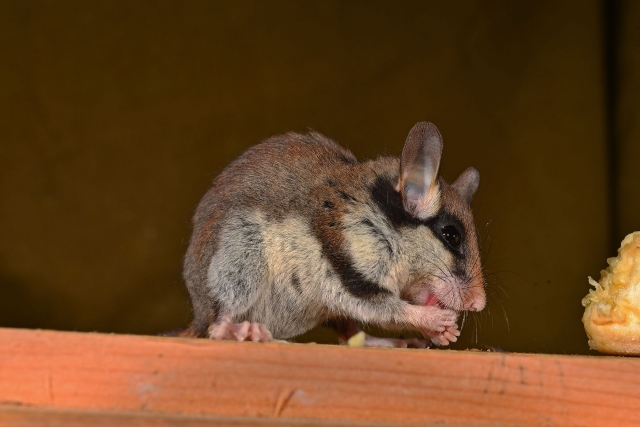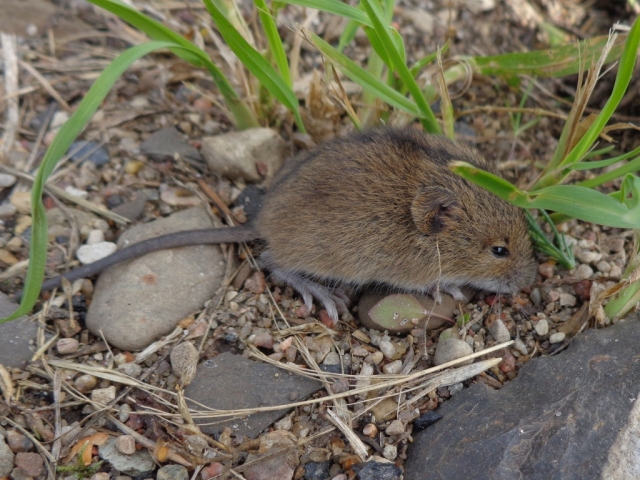Florian Heigl
European rabbit
Description
European rabbits have a grey-brown coat. In the neck area it is brown to rust-red in colour. In contrast to the European hare, it has relatively short ears (6-8 cm), is much more delicate (1.3 to 2.2 kg) and has shorter hind legs. The snout-vent length is between 35 and 45 cm, the tail (scut) is four to seven cm long.
Habitat
The ideal habitat of the European rabbit consists of short grassy areas with safe hiding places (e.g. burrows, rocks, hedges, bushes and woodland) near feeding areas. It can stay up to the tree line as long as the ground is well drained and provides shelter.
The text is a translation of an excerpt from Wikipedia (https://de.wikipedia.org/wiki/Wildkaninchen). On wikipedia the text is available under a „Creative Commons Attribution/Share Alike“ licence. Status: 19 August 2021
Squirrel
Description
In its body structure, the squirrel is adapted to a tree-dwelling and climbing lifestyle. It weights about 200-400 g. The snout-vent length is 20-25 cm. The two-lined, bushy tail is 15-20 cm long. It serves as a balancing aid when climbing and as a control tail when jumping. When running, the tail is always held in the air. The sexes cannot be distinguished by size and fur colour.
Squirrels are sole-walkers. They have four long, very mobile fingers with long curved claws on the front paws; the vestigial thumbs have a tiny nail attached. The hind legs are disproportionately long and very strong. The long, curved claws provide the squirrels with a good grip even when climbing quickly head over heels on smooth trunks.
The colour of the upperparts varies from light red to brown-black; the underpart is white or cream, neatly separated from the dorsal coat. The winter coat is much denser than the summer coat. In winter, the coat colour often becomes darker and can also take on grey tones. In the winter coat, squirrels have reddish-brown ear tufts up to 3.5 cm long. In the summer coat, these ear tufts are small or absent. In winter, the otherwise bare soles of the feet are also furred.
Habitat
The typical habitats are predominantly boreal coniferous forests. Only in the European part of the range are squirrels also native to deciduous and mixed forests. As a synanthropic species, they can be frequently found in parks and gardens.
The text is a translation of an excerpt from Wikipedia (https://de.wikipedia.org/wiki/Eurasisches_Eichhörnchen). On wikipedia the text is available under a „Creative Commons Attribution/Share Alike“ licence. Status: 19 August 2021
Groundhog
Description
The animals have a snout-vent length of about 40 to 50 cm. The tail length is 10 to 20 cm. The weight varies within the course of the year. Healthy adult males weight at least three kg. The weight of the females is slightly less.
The head is blackish and grey with a light-coloured snout. The ears are small and furry. The coat consists of dense, strong kemps and an undercoat of shorter, somewhat wavy hairs. The coat colour is basically very variable. The back can be slate grey, light brown or reddish brown, the underparts are usually more yellowish. Occasionally there are also individuals with a blackish coat. The coat is changed once a year. Most individuals change it in June.
The muscular and strong shoulder girdle and the pronounced digging paws are striking features of the Alpine groundhog's body. The front legs are a little shorter than the hind legs. The front feet have four toes, the hind feet five. Alpine groundhogs are sole walkers, the soles of their feet have well-developed pads and are not furred.
Habitat
The altitudes where most Alpine groundhogs occur range from the local tree line to about 200 m above it. Groundhogs also use cleared areas below the tree line that have been kept permanently free of trees by humans. However, they do not go below certain altitudes and are generally only observed above an altitude of at least 800 meters. In good groundhog areas, 40 to 80 groundhogs live on one square km.
Alpine groundhogs are able to cope with extreme alpine conditions and colonise alpine mats up to the foot of glaciers. They occasionally reach altitudes of 3000 m. A suitable habitat must have alpine grass, as this is the only place they can find sufficient food plants. It must also offer deep soil that enables the groundhogs to build their extensive burrows. They prefer south-facing slopes, as these are most likely to be free of snow in spring. On such slopes, the growing season also starts earlier and lasts longer.
The text is a translation of an excerpt from Wikipedia (https://de.wikipedia.org/wiki/Alpenmurmeltier). On wikipedia the text is available under a „Creative Commons Attribution/Share Alike“ licence. Status: 19 August 2021
Gopher
Description
The European gopher achieves a length of 18 to 23 cm without the tail. With the relatively long and densely furred tail, it adds another 5.5 to 7.5 cm. It weighs 200 to 430 g, depending on the season. The legs are relatively short. The yellow-grey fur on top is covered with white-yellow spots, these spots are missing on the sides of the body. Towards the more yellowish belly side the coat lightens slightly. The forehead and crown are shaded slightly darker than the back. The dark eyes are framed by a lighter ring.
Habitat
The gopher mostly lives in steppe areas and grasslands in north-eastern Austria.
The text is a translation of an excerpt from Wikipedia (https://de.wikipedia.org/wiki/Europäischer_Ziesel). On wikipedia the text is available under a „Creative Commons Attribution/Share Alike“ licence: 19 August 2021
Forest dormouse
Description
The nocturnal forest dormouse is easily recognised by its black face mask. On a light brown to grey background, it extends from the eyes to the front edge of the ears. Another clear distinguishing feature of the species is the unicoloured bushy tail, which is slightly greyer than the back.
Forest dormice are small dormice with medium-sized eyes and ears and a bushy tail. The snout-vent length is 80-113 mm, the tail length 73-119 mm, the length of the hind feet 19-24 mm and the ear length 10-15 mm. The animals weight 15-60 g. The coat colour on the upperparts ranges from reddish brown to yellowish brown to grey, the underpart is sharply contrasting greyish yellow. The tail, which is about the length of the body, is plain grey and only occasionally has a white tip. Fur length increases on the tail from the base to the tip. All feet have six sole pads.
Habitat
The forest dormouse lives exclusively in forests. In its large range, which extends far into Asia, a variety of forest types are colonised. Only dry pine forests with little undergrowth are avoided (Schedl 1968). In the Eastern Alps, the forest dormouse has been found in damp spruce and spruce-beech forests rich in undergrowth (Spitzenberger 2001).
The text is a translation of an excerpt from Wikipedia (https://de.wikipedia.org/wiki/Baumschläfer). On wikipedia the text is available under a „Creative Commons Attribution/Share Alike“ licence. Status: 19 August 2021
Garden dormouse
Description
Garden dormice are medium-sized dormice. The snout-vent length is 100-170 mm, the tail length 80-150 mm, the length of the hind feet 22-32 mm and the ear length 20-26 mm. The animals weight 45-140 g, before hibernation up to 210 g. The coat colour on the upperparts ranges from reddish brown to grey with a reddish brown tinge, flanks and underpart are white. A striking black head pattern extends from the rearmost whiskers over the eye area to behind and below the ears. There is a white patch in front of the ears and there is often dark pigmentation on the shoulders. The body-length, hairy tail has a long-haired terminal tassel and is greyish brown on the proximal half and blackish brown on the distal half. The underpart of the tail is white. The front feet have four pads, the hind feet six.
Habitat
Although the German name suggests otherwise, garden dormice live mainly in deciduous and coniferous forests, especially on rocky ground; they also inhabit orchards and home gardens. The animals occasionally inhabit raised hides and isolated buildings.
The text is a translation of an excerpt from Wikipedia (https://de.wikipedia.org/wiki/Gartenschläfer). On wikipedia the text is available under a „Creative Commons Attribution/Share Alike“ licence. Status: 19 August 2021
Hazel dormouse
Description
It weights 15 to 40 g and grows to a length of just under 15 cm, with almost half of the length (5.8 to 6.8 cm) being accounted for by the tail. The coat is yellow-brownish to reddish-brown with a white patch on the throat and chest, the tail is usually somewhat darker; pure white or black animals have also been recorded. They live 3 to 4 years in the wild and are sexually mature at one year.
Habitat
Their preferred habitat is dense bushes, hedges, wide forest margins and mixed forests with rich undergrowth. Hazel bushes (Corylus avellana) and bramble hedges are particularly popular. However, it seems to be quite adaptable and tolerant of noise, as individuals and nests have already been found in dividing strips of motorways planted with bushes.
The text is a translation of an excerpt from Wikipedia (https://de.wikipedia.org/wiki/Haselmaus). On wikipedia the text is available under a „Creative Commons Attribution/Share Alike“ licence. Status: 19 August 2021
Dormouse
Description
The appearance of this animal is reminiscent of squirrels and grey squirrels. But the dormouse is much smaller, has large black eyes, roundish ears and a less bushy tail. The face has no markings but long tactile hairs. The foot pads of these animals are always slightly moist and are such that dormice can climb trees and walls without any problems. The animals live up to 9 years and reach a weight of 70 to 160 g. The snout-vent length is 13 is 13 to 18 cm, plus the 11 to 15 cm long tail.
Habitat
These animals are found in deciduous forests or large gardens (ideal: orchards). The dormouse likes to find its sleeping quarters in tree holes, nesting aids and also under the roofs of houses. While it sleeps there during the day, it tends to run around at night and can make so much noise that it could be attributed to an adult human, such as a burglar, and not to such a small animal.
The text is a translation of an excerpt from Wikipedia (https://de.wikipedia.org/wiki/Siebenschläfer). On wikipedia the text is available under a „Creative Commons Attribution/Share Alike“ licence. Status: 19 August 2021
Beaver
Description
Adult European beavers weight between 23 and 30 kg and have snout-vent lengths of 83 to 102 cm and tail lengths of 30 to 35 cm. The body is plump and stocky and increases in volume towards the back. The head is short, broad and flattened at the top, so that it merges directly into the strong neck muscles and the rump. The eyes and ears, which are very high up, as well as the snout, are above water even when the body is submerged.
Front and hind legs are short. The front feet are trained for grasping and have five fingers. The hind feet are large and have webbed toes, the second hind toe has a double claw for grooming the fur. The very dense coat is grey to dark brown or black on the underpart, lighter underneath. The tail is flat, broad, hairless and covered with scales. It serves as a control, propulsion organ and fat depot.
Habitat
Like all beavers, they live semi-aquatic and inhabit water bodies and their banks.
The text is a translation of an excerpt from Wikipedia (https://de.wikipedia.org/wiki/Europäischer_Biber). On wikipedia the text is available under a „Creative Commons Attribution/Share Alike“ licence. Status: 19 August 2021
Northern birch mouse
Description
The tiny Northern birch mouse is even smaller than the Eurasian harvest mouse. It reaches a snout-vent length of 50 to 72 mm, a tail length of 140 to 150 % of the snout-vent length and a weight of 5 to 11 g. The upperpart is yellow-grey with blackish streaking and a dark dorsal stripe, the underpart is light grey.
Habitat
The Northern birch mouse prefers damp to swampy areas with a lot of cover. Except in bogs and wet meadows, it lives in forests. In the mountains it can be found up to 2000 m altitude.
The text is a translation of an excerpt from Wikipedia (https://de.wikipedia.org/wiki/Waldbirkenmaus). On wikipedia the text is available under a „Creative Commons Attribution/Share Alike“ licence. Status: 20 August 2021










